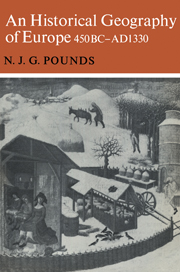5 - Europe about the year 1100
Published online by Cambridge University Press: 05 June 2012
Summary
At the turn of the twelfth century Europe was in a condition of rapid change and growth. The incursions of the Northmen had at last been checked. The last wave of Ural-Altaic settlers from the Russian steppe was well on the way towards assimilation, and in the south the drawn-out struggle with the forces of Islam had turned decisively in favour of Europe. Advance was still slow in Spain, but in the eastern Mediterranean European peoples had gone over to an offensive, both commercial and military.
Within Europe itself, the division between the west, the heir of Rome, and the Byzantine south-east, implicit since the third century, had now come into the open, and the formal schism, which developed in the eleventh century, was to continue through the rest of the Middle Ages. On the other hand, the sphere of western civilisation, as if to redress the balance, was at this time being extended into Scandinavia, the middle Danube basin, and eastward across the plains of Poland.
Population within Europe was increasing more rapidly than at any time in the previous thousand years. The forest was yielding to the settler's axe, and the area of land under cultivation was keeping pace with the rising population. Long-distance trade, a product both of mounting population and of a rising level of welfare, was being developed anew, and from Italy to Flanders and from Spain to Poland, small urban communities were coming into existence under the protection of monastery or castle or within the crumbling walls of former Roman towns.
- Type
- Chapter
- Information
- An Historical Geography of Europe 450 B.C.–A.D. 1330 , pp. 227 - 312Publisher: Cambridge University PressPrint publication year: 1973



